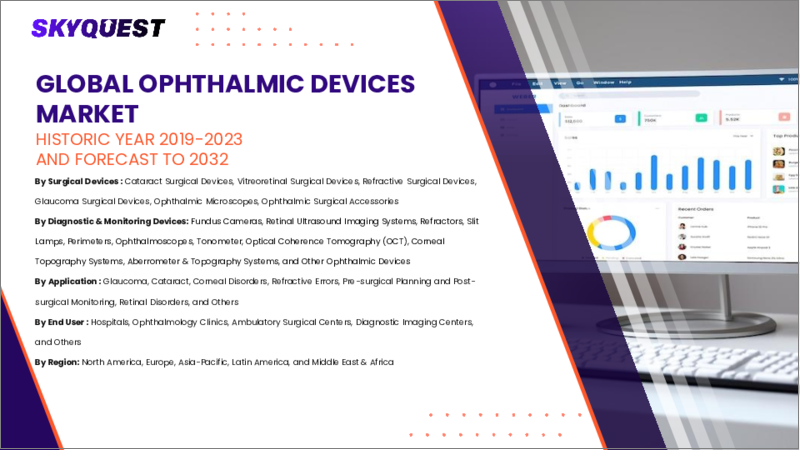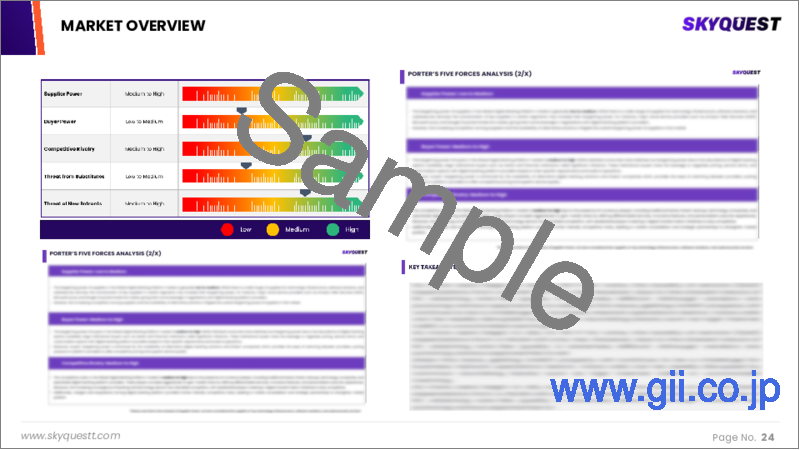|
|
市場調査レポート
商品コード
1619119
眼科医療機器市場規模、シェア、成長分析、製品別、エンドユーザー別、用途別、地域別-産業別予測2024~2031年Ophthalmic Devices Market Size, Share, Growth Analysis, By Product (Diagnostic and Monitoring Devices, Optical Coherence Tomography Scanners), By End User (Consumers, Hospitals), By Application, By Region - Industry Forecast 2024-2031 |
||||||
|
|||||||
| 眼科医療機器市場規模、シェア、成長分析、製品別、エンドユーザー別、用途別、地域別-産業別予測2024~2031年 |
|
出版日: 2024年12月18日
発行: SkyQuest
ページ情報: 英文 260 Pages
納期: 3~5営業日
|
全表示
- 概要
- 目次
眼科医療機器の世界市場規模は、2022年に414億米ドルと評価され、2023年の435億5,000万米ドルから2031年には653億3,000万米ドルに成長し、予測期間(2024~2031年)のCAGRは5.2%で成長する展望です。
眼科医療機器市場は、主に緑内障や白内障などの眼疾患の有病率の上昇によって大きな成長を遂げています。手術、検査、視力矯正に不可欠なこれらの専門医療器具は、このような眼疾患の急増の中でますます重要性を増しています。技術の進歩、特に眼内レンズ(IOL)の開発は、眼病に関する眼科医療専門家への教育的取り組みへの関心の高まりとともに、この市場拡大において重要な役割を果たしています。さらに、視力矯正のための革新的なデバイスを目指した研究開発努力の増加と、眼科ソリューションに対する消費者の意識の高まりが、市場の成長をさらに加速させると予想されます。全体として、眼科医療機器市場は堅調な拡大が見込まれています。
目次
イントロダクション
- 調査の目的
- 調査範囲
- 定義
調査手法
- 情報調達
- 二次データと一次データの方法
- 市場規模予測
- 市場の前提条件と制限
エグゼクティブサマリー
- 世界市場の展望
- 供給と需要の動向分析
- セグメント別機会分析
市場力学と展望
- 市場概要
- 市場規模
- 市場力学
- 促進要因と機会
- 抑制要因と課題
- ポーターの分析
主要市場の考察
- 重要成功要因
- 競合の程度
- 主要投資機会
- 市場エコシステム
- 市場の魅力指数(2023年)
- PESTEL分析
- マクロ経済指標
- バリューチェーン分析
- 価格分析
眼科医療機器市場規模:製品別&CAGR(2024~2031年)
- 市場概要
- 診断とモニタリングデバイス
- 光干渉断層撮影装置
- 眼科用超音波画像診断システム
- 眼科用Aスキャンバイオメーター
- 眼科Bスキャン超音波
- 眼科用UBM超音波
- 眼科用パキメーター
- 眼底カメラ
- 検眼鏡
- 網膜鏡
- 波面収差計
- 角膜トポグラフィーシステム
- オートレフラクトメーターと角膜計
- フォロプター
- スペキュラー顕微鏡
- 視野計/視野分析装置
- 眼圧計
- スリットランプ
- レンズメーター
- 光学生体測定システム
- チャートプロジェクター
- 外科用機器
- 白内障手術装置
- 眼内レンズ(IOLS)
- 眼科用粘弾性デバイス(OVDS)
- 超音波乳化吸引装置
- 白内障手術レーザー
- IOLインジェクター
- 硝子体網膜手術装置
- 硝子体切除術用機器
- 硝子体網膜パック
- 光凝固レーザー
- 照明装置
- 硝子体切除プローブ
- バックフラッシュ
- シャンデリア
- 屈折矯正手術装置
- エキシマレーザー
- フェムト秒レーザー
- その他のレーザー
- 緑内障手術装置
- 緑内障ドレナージデバイス(GDDS)
- 微小侵襲性緑内障手術装置
- 緑内障レーザーシステム
- 眼科用顕微鏡
- アクセサリー
- 手術器具
- ヒントとハンドル
- はさみ
- 鉗子
- ヘラ
- 黄斑レンズ
- カニューレ
- その他の眼科手術用付属品
- ビジョンケア
- 眼鏡
- コンタクトレンズ
- 柔らかい
- RGP
- ハイブリッド
眼科医療機器市場規模:エンドユーザー別&CAGR(2024~2031年)
- 市場概要
- 消費者
- 病院
- 専門クリニックと外来手術センター
- その他
眼科医療機器市場規模:用途別&CAGR(2024~2031年)
- 市場概要
- 白内障
- 硝子体網膜疾患
- 緑内障
- 屈折異常
眼科医療機器市場規模&CAGR(2024~2031年)
- 北米
- 米国
- カナダ
- 欧州
- ドイツ
- スペイン
- フランス
- 英国
- イタリア
- その他の欧州
- アジア太平洋
- 中国
- インド
- 日本
- 韓国
- その他のアジア太平洋
- ラテンアメリカ
- ブラジル
- その他のラテンアメリカ
- 中東・アフリカ
- GCC諸国
- 南アフリカ
- その他の中東・アフリカ
競合情報
- 上位5社の比較
- 主要企業の市場ポジショニング(2023年)
- 主要市場企業が採用した戦略
- 市場の最近の動向
- 企業の市場シェア分析(2023年)
- 主要企業の企業プロファイル
- 製品ポートフォリオ分析
- セグメント別シェア分析
- 収益の前年比比較(2021~2023年)
主要企業プロファイル
- Alcon(スイス)
- Johnson & Johnson Vision(米国)
- Carl Zeiss Meditec AG(ドイツ)
- Hoya Corporation(日本)
- EssilorLuxottica(フランス)
- Bausch+Lomb(米国)
- Nidek Co., Ltd.(日本)
- Topcon Corporation(日本)
- Glaukos Corporation(米国)
- Abbott Laboratories(米国)
- CooperVision, Inc.(米国)
- STAAR Surgical Company(米国)
- Ziemer Ophthalmic Systems AG(スイス)
- Haag-Streit AG(スイス)
- Quantel Medical(フランス)
- Canon Inc.(日本)
- Heidelberg Engineering GmbH(ドイツ)
- Menicon Co., Ltd.(日本)
結論と推奨事項
Global Ophthalmic Devices Market size was valued at USD 41.4 billion in 2022 and is poised to grow from USD 43.55 billion in 2023 to USD 65.33 billion by 2031, growing at a CAGR of 5.2% during the forecast period (2024-2031).
The ophthalmic devices market is experiencing significant growth, primarily driven by the rising prevalence of eye disorders such as glaucoma and cataracts. These specialized medical tools, essential for surgeries, examinations, and vision correction, are becoming increasingly important amid this surge in ocular issues. Technological advancements, particularly the development of intraocular lenses (IOLs), play a crucial role in this market expansion, alongside a heightened focus on educational initiatives for eye care professionals concerning eye diseases. Furthermore, an increase in research and development efforts aimed at innovative devices for vision correction, coupled with growing consumer awareness of ophthalmic solutions, are anticipated to further accelerate market growth. Overall, the ophthalmic devices market is poised for robust expansion.
Top-down and bottom-up approaches were used to estimate and validate the size of the Global Ophthalmic Devices market and to estimate the size of various other dependent submarkets. The research methodology used to estimate the market size includes the following details: The key players in the market were identified through secondary research, and their market shares in the respective regions were determined through primary and secondary research. This entire procedure includes the study of the annual and financial reports of the top market players and extensive interviews for key insights from industry leaders such as CEOs, VPs, directors, and marketing executives. All percentage shares split, and breakdowns were determined using secondary sources and verified through Primary sources. All possible parameters that affect the markets covered in this research study have been accounted for, viewed in extensive detail, verified through primary research, and analyzed to get the final quantitative and qualitative data.
Global Ophthalmic Devices Market Segmental Analysis
Global Ophthalmic Devices Market is segmented by product, end user, application and region. Based on product, the market is segmented into diagnostic and monitoring devices, surgical devices and vision care. Based on end user, the market is segmented into consumers, hospitals, specialty clinics and ambulatory surgery centers and other end users. Based on application, the market is segmented into cataract, vitreo retinal disorders, glaucoma and refractor disorders. Based on region, the market is segmented into North America, Europe, Asia Pacific, Latin America and Middle East & Africa.
Driver of the Global Ophthalmic Devices Market
The global ophthalmic devices market is driven by the increasing prevalence of severe eye disorders, which have emerged as a pressing public health concern. The growing incidence of conditions such as diabetic retinopathy and ocular hypertension is largely attributable to the aging population alongside rising rates of chronic diseases like diabetes and hypertension. This trend is anticipated to fuel global demand for ophthalmic devices. Additionally, developing nations are expected to experience particularly strong market growth due to enhanced governmental initiatives and support. Ongoing advancements in ophthalmic technologies aim to introduce innovative solutions, further amplifying the demand for ophthalmic equipment in the foreseeable future.
Restraints in the Global Ophthalmic Devices Market
The Global Ophthalmic Devices market faces several constraints, primarily attributed to the high cost of advanced technology, such as femtosecond lasers, which, despite their benefits of reduced operating times and improved patient outcomes, can be prohibitively expensive and hinder market growth. Additionally, in many developing nations like India, Saudi Arabia, Israel, Kenya, and South Africa, there is a significant lack of awareness regarding eye disorders among rural populations. This lack of knowledge, coupled with limited or no access to advanced ophthalmic devices, further exacerbates the challenges faced by the market, slowing its expansion in these regions.
Market Trends of the Global Ophthalmic Devices Market
The Global Ophthalmic Devices market is experiencing a robust upward trend, driven by the increasing adoption of advanced and technologically sophisticated instruments for diagnosing and treating eye conditions. Innovations in minimally invasive procedures, such as the various incision options in cataract surgeries and advancements in vitrectomy, are enhancing patient outcomes and safety. The introduction of Femtosecond laser technology, pivotal in procedures like Femto-LASIK, has further fueled the demand for laser-based devices. As these cutting-edge treatments gain traction in cataract surgeries and other interventions, the ophthalmic devices market is poised for significant growth, promising a wealth of opportunities in the coming years.
Table of Contents
Introduction
- Objectives of the Study
- Scope of the Report
- Definitions
Research Methodology
- Information Procurement
- Secondary & Primary Data Methods
- Market Size Estimation
- Market Assumptions & Limitations
Executive Summary
- Global Market Outlook
- Supply & Demand Trend Analysis
- Segmental Opportunity Analysis
Market Dynamics & Outlook
- Market Overview
- Market Size
- Market Dynamics
- Drivers & Opportunities
- Restraints & Challenges
- Porters Analysis
- Competitive rivalry
- Threat of substitute
- Bargaining power of buyers
- Threat of new entrants
- Bargaining power of suppliers
Key Market Insights
- Key Success Factors
- Degree of Competition
- Top Investment Pockets
- Market Ecosystem
- Market Attractiveness Index, 2023
- PESTEL Analysis
- Macro-Economic Indicators
- Value Chain Analysis
- Pricing Analysis
Global Ophthalmic Devices Market Size by Product & CAGR (2024-2031)
- Market Overview
- Diagnostic and Monitoring Devices
- Optical Coherence Tomography Scanners
- Ophthalmic Ultrasound Imaging Systems
- Ophthalmic A Scan Biometers
- Ophthalmic B Scan Ultrasound
- Ophthalmic UBM Ultrasound
- Ophthalmic Pachymeter
- Fundus Camera
- Ophthalmoscopes
- Retinoscope
- Wavefront Aberrometer
- Corneal Topography Systems
- Autorefractors and Keratometers
- Phoropters
- Specular Microscope
- Perimeters/Visual Field Analyzers
- Tonometer
- Slit Lamps
- Lensometer
- Optical Biometry Systems
- Chart Projectors
- Surgical Devices
- Cataract Surgery Devices
- Intraocular Lens (IOLS)
- Ophthalmic Viscoelastic Devices (OVDS)
- Phacoemulsification Devices
- Cataract Surgery Lasers
- Iol Injectors
- Vitreoretinal Surgery Devices
- Vitrectomy Machines
- Vitreoretinal Packs
- Photocoagulation Lasers
- Illumination Devices
- Vitrectomy Probes
- Backflush
- Chandelier
- Refractive Surgery Devices
- Excimer Lasers
- Femtosecond Lasers
- Other Lasers
- Glaucoma Surgery Devices
- Glaucoma Drainage Devices (GDDS)
- Microinvasive Glaucoma Surgery Devices
- Glaucoma Laser Systems
- Ophthalmic Microscopes
- Accessories
- Surgical Sets & Instruments
- Tips & Handles
- Scissors
- Forceps
- Spatulas
- Macular Lenses
- Cannulas
- Other Ophthalmic Surgical Accessories
- Vision Care
- Spectacles
- Contact Lenses
- Soft
- RGP
- Hybrid
Global Ophthalmic Devices Market Size by End User & CAGR (2024-2031)
- Market Overview
- Consumers
- Hospitals
- Specialty Clinics and Ambulatory Surgery Centers
- Other End Users
Global Ophthalmic Devices Market Size by Application & CAGR (2024-2031)
- Market Overview
- Cataract
- Vitreo Retinal Disorders
- Glaucoma
- Refractor Disorders
Global Ophthalmic Devices Market Size & CAGR (2024-2031)
- North America (Product, End User, Application)
- USA
- Canada
- Europe (Product, End User, Application)
- Germany
- Spain
- France
- UK
- Italy
- Rest of Europe
- Asia Pacific (Product, End User, Application)
- China
- India
- Japan
- South Korea
- Rest of Asia-Pacific
- Latin America (Product, End User, Application)
- Brazil
- Rest of Latin America
- Middle East & Africa (Product, End User, Application)
- GCC Countries
- South Africa
- Rest of Middle East & Africa
Competitive Intelligence
- Top 5 Player Comparison
- Market Positioning of Key Players, 2023
- Strategies Adopted by Key Market Players
- Recent Developments in the Market
- Company Market Share Analysis, 2023
- Company Profiles of All Key Players
- Company Details
- Product Portfolio Analysis
- Company's Segmental Share Analysis
- Revenue Y-O-Y Comparison (2021-2023)
Key Company Profiles
- Alcon (Switzerland)
- Company Overview
- Business Segment Overview
- Financial Updates
- Key Developments
- Johnson & Johnson Vision (USA)
- Company Overview
- Business Segment Overview
- Financial Updates
- Key Developments
- Carl Zeiss Meditec AG (Germany)
- Company Overview
- Business Segment Overview
- Financial Updates
- Key Developments
- Hoya Corporation (Japan)
- Company Overview
- Business Segment Overview
- Financial Updates
- Key Developments
- EssilorLuxottica (France)
- Company Overview
- Business Segment Overview
- Financial Updates
- Key Developments
- Bausch + Lomb (USA)
- Company Overview
- Business Segment Overview
- Financial Updates
- Key Developments
- Nidek Co., Ltd. (Japan)
- Company Overview
- Business Segment Overview
- Financial Updates
- Key Developments
- Topcon Corporation (Japan)
- Company Overview
- Business Segment Overview
- Financial Updates
- Key Developments
- Glaukos Corporation (USA)
- Company Overview
- Business Segment Overview
- Financial Updates
- Key Developments
- Abbott Laboratories (USA)
- Company Overview
- Business Segment Overview
- Financial Updates
- Key Developments
- CooperVision, Inc. (USA)
- Company Overview
- Business Segment Overview
- Financial Updates
- Key Developments
- STAAR Surgical Company (USA)
- Company Overview
- Business Segment Overview
- Financial Updates
- Key Developments
- Ziemer Ophthalmic Systems AG (Switzerland)
- Company Overview
- Business Segment Overview
- Financial Updates
- Key Developments
- Haag-Streit AG (Switzerland)
- Company Overview
- Business Segment Overview
- Financial Updates
- Key Developments
- Quantel Medical (France)
- Company Overview
- Business Segment Overview
- Financial Updates
- Key Developments
- Canon Inc. (Japan)
- Company Overview
- Business Segment Overview
- Financial Updates
- Key Developments
- Heidelberg Engineering GmbH (Germany)
- Company Overview
- Business Segment Overview
- Financial Updates
- Key Developments
- Menicon Co., Ltd. (Japan)
- Company Overview
- Business Segment Overview
- Financial Updates
- Key Developments





